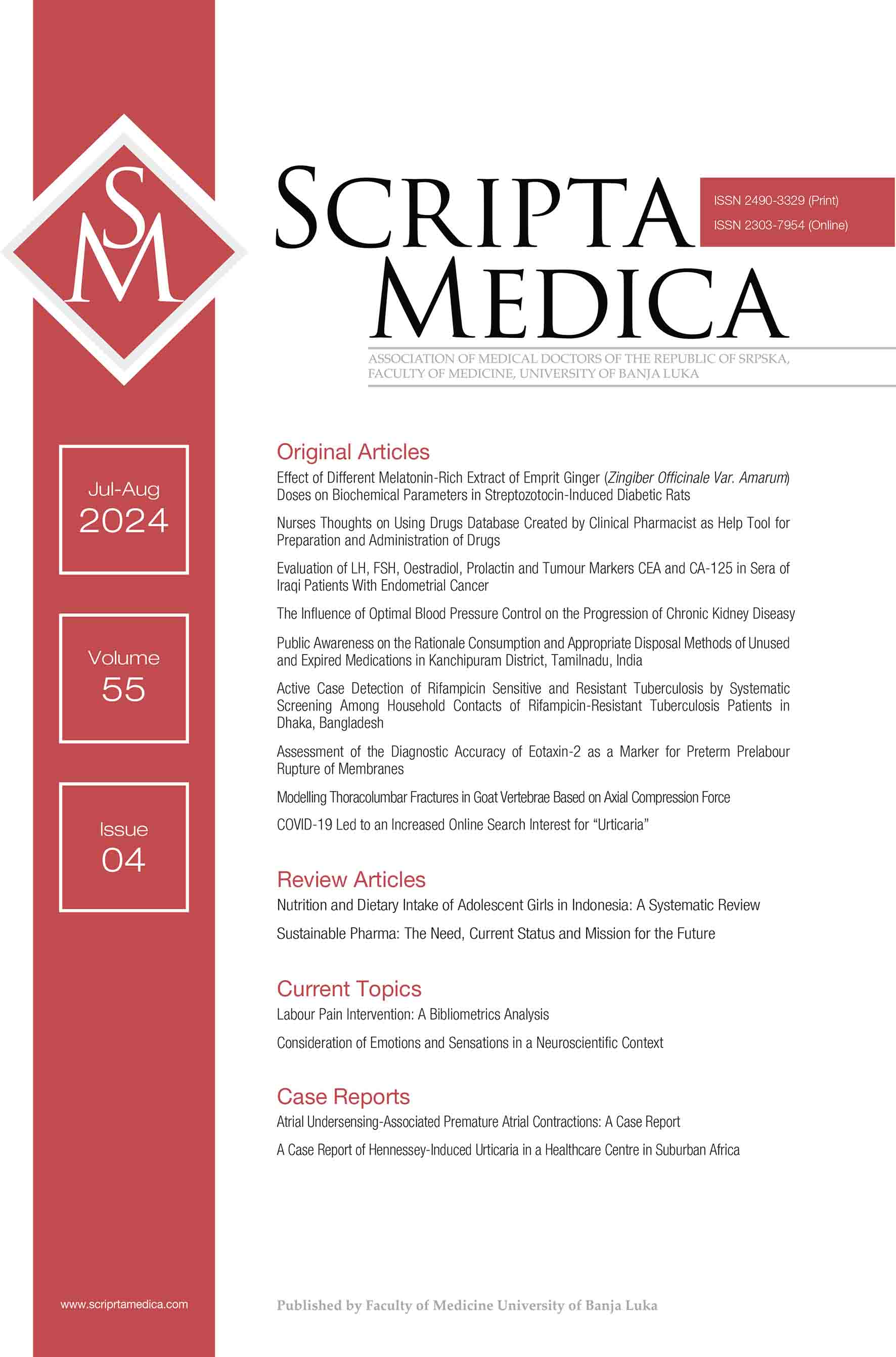Assessment of the Diagnostic Accuracy of Eotaxin-2 as a Marker for Preterm Prelabour Rupture of Membranes
Abstract
Background/Aim: Preterm pre-labour rupture of the membranes could be caused by the change in local cytokines concentration due to inflammatory or infectious conditions. Cytokines, such as chemokine generated by immune cells that have been activated are the most extensive category of biochemical factors implicated in the development of preterm pre-labour rupture of the membranes (PPROM). Among this chemokine, eotaxin serves as a specific protein that attracts eosinophils. Aim of this study was to assess the diagnostic accuracy of eotaxin-2 as a marker for the diagnosis of PPROM.
Methods: A case-control study was conducted in the Department of Obstetrics and Gynaecology at Bagdad Teaching Hospital, Iraq during a period of 10 months. The study sample included 90 pregnant women and was divided into three groups, the first group: 30 women with PPROM, the second group: 30 women with preterm labour and intact foetal membranes and the third group: 30 women at term pregnancy. For all women in the study blood samples were taken for measurement of eotaxin-2 at the same gestational age.
Results: The eotaxin-2 level was found to be lower in cases of PPROM than in preterm labour and term cases. The sensitivity of eotaxin-2 was 83.3 %, specificity 70 % and negative predictive value 89.4 %.
Conclusion: Eotaxin-2 might be considered as a marker for diagnosis of PPROM.
References
Ha S, Liu D, Zhu Y, Sherman S, Mendola P. Acute associations between outdoor temperature and premature rupture of membranes. Epidemiology. 2018;29(2):175-82. doi: 10.1097/ede.0000000000000779.
Niyaty S, Moghaddam-Banaem L, Sourinejad H, Mokhlesi S. Are maternal metabolic syndrome and lipid profile associated with preterm delivery and preterm premature rupture of membranes? Arch Gynecol Obstet. 2021;303(1):113-9. doi: 10.1007/s00404-020-05738-5.
Cunningham FG, Leveno KJ, Bloom SL, Spong CY, Dashe JS. Preterm Birth. Williams obstetrics. 24th ed. New York, NY, USA: McGraw-Hill; 2014. p. 811.
Liu Y, Liu Y, Du C, Zhang R, Feng Z, Zhang J. Diagnostic value of amniotic fluid inflammatory biomarkers for subclinical chorioamnionitis. Int J Gynecol Obstet. 2016;134(2):160-4. doi: https://doi.org/10.1016/j.ijgo.2016.01.007.
Maheshwari A, Khuder S, Lawrence SM, Christensen RD. Neonatal immunity. Principles of neonatology. Amsterdam, NA: Elsevier; 2024. p. 484-97.
Kume H, Harigane R, Rikimaru M. Involvement of lysophospholipids in pulmonary vascular functions and diseases. Biomedicines. 2024;12(1):124. doi: 10.3390/biomedicines12010124.
Tsakiridis I, Mamopoulos A, Chalkia-Prapa E-M, Athanasiadis A, Dagklis T. Preterm premature rupture of membranes: a review of 3 national guidelines. Obstet Gynecol Surv. 2018;73(6):368-75. doi: 10.1097/ogx.0000000000000567.
Gafner M, Borovich A, Gimpel A, Peled Y, Meshulam M, Krissi H. Risk factors and maternal outcomes following preterm premature rupture of membrane in the second trimester of gestation. Arch Gynecol Obstet. 2020;301(5):1207-12. doi: 10.1007/s00404-020-05533-2.
Sae-Lin P, Wanitpongpan P. Incidence and risk factors of preterm premature rupture of membranes in singleton pregnancies at Siriraj Hospital. J Obstet Gynaecol Res. 2019;45(3):573-7. doi: 10.1111/jog.13886.
Oliver-Williams C, Fleming M, Wood A, Smith G. Previous miscarriage and the subsequent risk of preterm birth in Scotland, 1980–2008: a historical cohort study. BJOG. 2015;122(11):1525-34. doi: 10.1111/1471-0528.13276.
Lutsiv O, Mah J, Beyene J, McDonald S. The effects of morbid obesity on maternal and neonatal health outcomes: a systematic review and meta‐analyses. Obes Rev. 2015;16(7):531-46. doi: 10.1111/obr.12283.
Torloni MR, Betran AP, Daher S, Widmer M, Dolan SM, Menon R, et al. Maternal BMI and preterm birth: a systematic review of the literature with meta-analysis. J Matern Fetal Neonatal Med. 2009;22(11):957-70. doi: 10.3109/14767050903042561.
Cai C, Vandermeer B, Khurana R, Nerenberg K, Featherstone R, Sebastianski M, et al. The impact of occupational activities during pregnancy on pregnancy outcomes: a systematic review and metaanalysis. Am J Obstet Gynecol. 2020;222(3):224-38. doi: 10.1016/j.ajog.2019.08.059.
Pius S, Idrisa A, Bukar M. Maternal and neonatal outcomes in premature rupture of membranes at University of Maiduguri Teaching Hospital, Maiduguri, North-Eastern Nigeria. Trop J Obstet Gynaecol. 2019;36(1):15. doi: 10.4103/tjog.tjog_89_18.
Zhou Q, Zhang W, Xu H, Liang H, Ruan Y, Zhou S, et al. Risk factors for preterm premature rupture of membranes in Chinese women from urban cities. Int J Gynaecol Obstet. 2014;127(3):254-9. doi: 10.1016/j.ijgo.2014.06.020.
Gat R, Kachko E, Kloog I, Erez O, Yitshak-Sade M, Novack V, et al. Differences in environmental factors contributing to preterm labor and PPROM – Population based study. Environmental Research. 2021;196:110894. doi: 10.1016/j.envres.2021.110894.
Esteves JS, de Sá RAM, de Carvalho PRN, Coca Velarde LG. Neonatal outcome in women with preterm premature rupture of membranes (PPROM) between 18 and 26 weeks. J Maternal-Fetal Neonat Med. 2016;29(7):1108-12. doi: 10.3109/14767058.2015.1035643.
Lovereen S, Khanum MA, Nargis N, Begum S, Afroze R. Maternal and Neonatal outcome in premature rupture of membranes. BJMS. 2018;17(3):479-83. doi: 10.3329/bjms.v17i3.37004.
Raba G, Kacerovsky M, Laudański P. Eotaxin-2 as a potential marker of preterm premature rupture of membranes: A prospective, cohort, multicenter study. Adv Clin Exp Med. 2021;30(2):197-202. doi: 10.17219/acem/130609.
Lee SM, Park KH, Jung EY, Kook SY, Park H, Jeon SJ. Inflammatory proteins in maternal plasma, cervicovaginal and amniotic fluids as predictors of intra-amniotic infection in preterm premature rupture of membranes. PLOS ONE. 2018;13(7):e0200311. doi: 10.1371/journal.pone.0200311.
- Authors retain copyright and grant the journal right of first publication with the work simultaneously licensed under a Creative Commons Attribution License that allows others to share the work with an acknowledgement of the work's authorship and initial publication in this journal.
- Authors are able to enter into separate, additional contractual arrangements for the non-exclusive distribution of the journal's published version of the work (e.g., post it to an institutional repository or publish it in a book), with an acknowledgement of its initial publication in this journal.
- Authors are permitted and encouraged to post their work online (e.g., in institutional repositories or on their website) prior to and during the submission process, as it can lead to productive exchanges, as well as earlier and greater citation of published work (See The Effect of Open Access).

